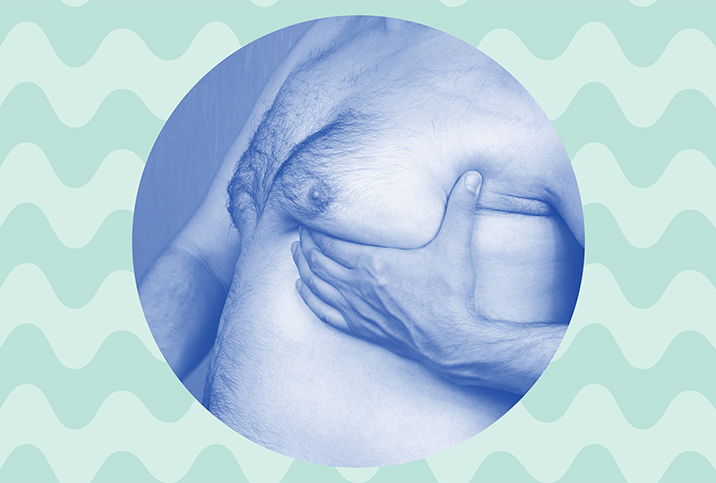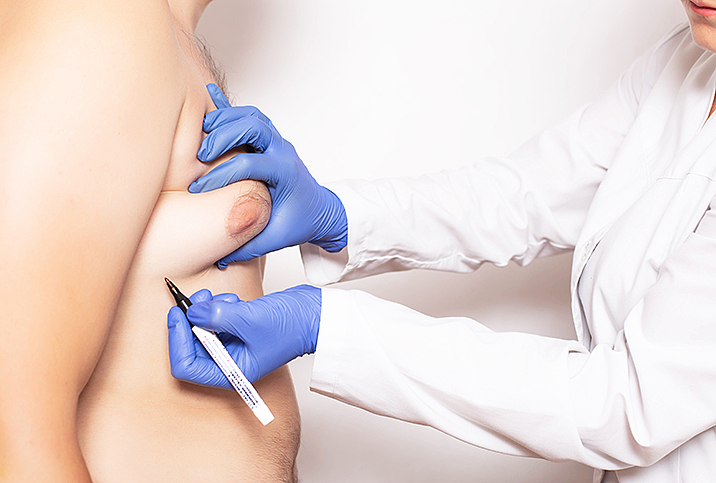Please Stop Believing These Gynecomastia Inaccuracies

Gynecomastia can be a confusing experience for people going through it. A benign condition in which the breast tissue of males becomes enlarged, gynecomastia affects about 30 percent of males.
This condition can be caused by any increase in breast ductal tissue, stroma or even fat. It can be so pronounced that the breasts resemble well-developed female breasts. Its causes can include hormonal fluctuations or changes (primarily high estrogen levels), medications or anabolic steroids that cause an increase in estrogen production or a decrease in androgens, or certain medical conditions.
The noticeable breast tissue can cause some people with the condition to feel shame or embarrassment. As a result, some men don't fully communicate with their medical team, or even loved ones, about what they are experiencing.
Because of this, many misconceptions exist about the condition, but here are five myths you definitely need to stop believing about enlarged male breast tissue.
Inaccuracy No. 1
Gynecomastia only occurs in men who are overweight.
The belief that gynecomastia only occurs in men who are overweight is the "absolute most common misconception," said Javad Sajan, M.D., a plastic surgeon with Allure Esthetic in Seattle.
Men of all sizes can, and do, develop gynecomastia, according to Sajan. Obesity or being overweight can contribute because the condition can be caused by enlarged fat tissue. However, malnourishment and starvation can also lead to gynecomastia. The drop in hormones will drastically switch when someone starts eating again, triggering a state similar to puberty.
Any man can develop gynecomastia. It is more common in those who have a predisposition for an abnormal testosterone-to-estrogen ratio, explained Majdee Islam, M.D., a urologist and men's health specialist at Urology of St. Louis.
"It is not uncommon, in particular in older men and in boys and teenagers going through puberty as well, both due to the different hormonal changes occurring in these populations," he said.
Inaccuracy No. 2
Gynecomastia can be prevented.
Islam said the most common misconception he sees about the condition is that it could have somehow been avoided or prevented with lifestyle changes.
Rarely, some such changes can help. More often, though, there is an underlying factor, such as a hormone imbalance, that was the culprit rather than anything someone did or didn't do.
"[These are] things that are out of their control," he explained.
Inaccuracy No. 3
Gynecomastia is a permanent condition.
Males who develop enlarged breast tissue may rightly worry their new condition is permanent. Sajan explained that long-lasting gynecomastia isn't always a guarantee for everyone who develops it. The condition will persist in some cases, but it is possible for gynecomastia to resolve on its own.
It can resolve during puberty as well as in those cases where the cause is quickly identified and treated. The most common ages for males to develop gynecomastia include, according to the National Library of Medicine (NLM):
- During the initial newborn phase, thanks to circulating hormones from the mother
- During puberty as hormone levels fluctuate
- Around age 60 as hormones shift again and adipose (fatty) tissue increases
Depending on the exact circumstances causing the gynecomastia, as well as the age of the person experiencing it, it is possible for it to go away on its own, Sajan said.
Inaccuracy No. 4
Gynecomastia is not dangerous.
In most cases, the condition is not dangerous and occurs in about 60 percent of males at puberty. In rare cases, though, gynecomastia can be a sign that something is wrong, according to Sajan.
The enlarged breast tissue itself is benign, but the fact that it develops in males could indicate the presence of a significant medical condition. For instance, certain types of tumors can cause gynecomastia to develop. The condition can occur as a result of health issues, including:
- Liver disease
- Kidney damage and failure
- Hyperthyroidism
- Being intersex (aka hermaphroditism)
- Type 1 diabetes
- Stress
From a doctor's perspective, gynecomastia is not considered a disease process in itself. It's more often a symptom of something else going on in the body, such as an underlying hormonal imbalance, Islam said. It's the underlying issue that will most likely cause other symptoms, such as sexual dysfunction and fatigue.
Gynecomastia, somewhat reassuringly, is not a primary symptom and doesn't increase the risk of breast cancer in men. In fact, only about 1 percent of males with breast enlargement are actually diagnosed with breast cancer.
Inaccuracy No. 5
Surgery cures gynecomastia completely.
Surgery may be helpful and a relief to someone who is uncomfortable with their body as a result of gynecomastia, but it's not always a complete cure. The condition can recur, Sajan said, even after surgery, if the cause is not adequately treated.
For that reason, he recommended anyone experiencing the condition work with their doctor to identify the exact cause before they undergo surgery. That way, they can be sure to address the root cause and try to prevent recurrence following surgical intervention.
The bottom line
As a condition that's received some shame and stigma, gynecomastia can be misunderstood. The bottom line, though, is it's a condition that can happen to anyone with male hormones. While it's not usually dangerous, it's still important to see a doctor if you have any breast enlargement.
"It is important to perform self-exams and be seen by a professional to ensure that it is not developing into something that is dangerous like breast cancer—which is rare in men—but can happen," Islam said.
Concerned about the results of any self-exam—breast, testicular or otherwise? Talk to a medical professional who can take your history and evaluate your situation. If you don't have a doctor you see regularly, telehealth makes it easy to connect with one.
Giddy Telehealth is an easy-to-use online portal that provides access to hundreds of healthcare professionals whose expertise covers the full scope of medical care. Many of them offer same-day video visits.


















